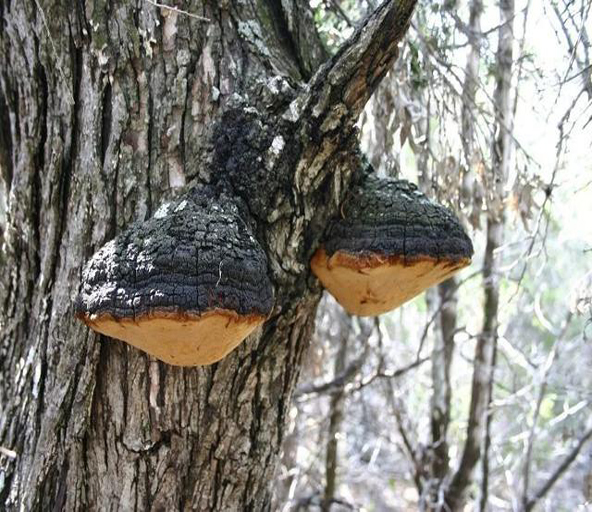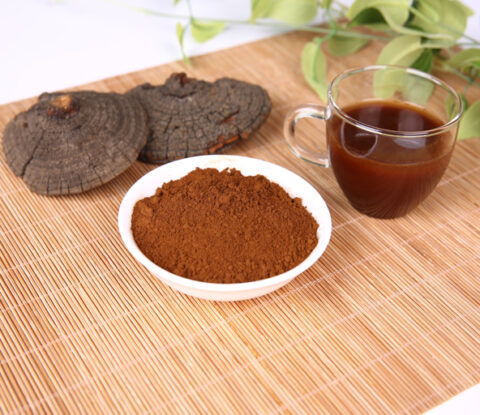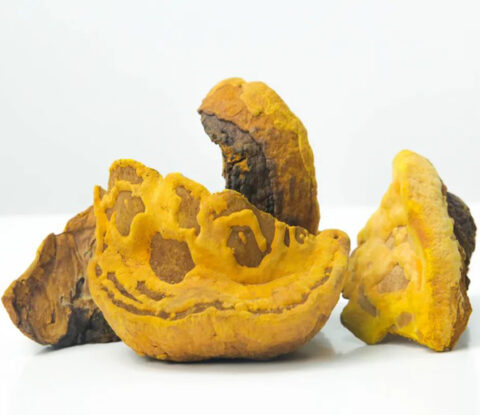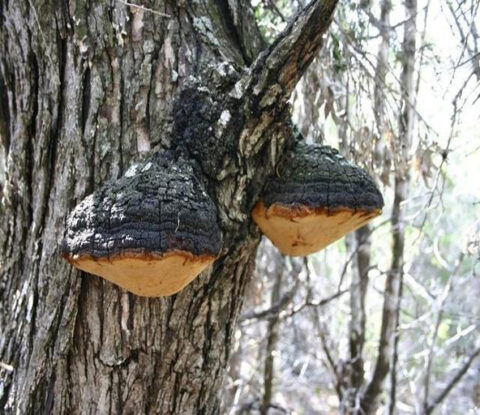
Phellinus Linteus Beta Glucan, Phellinus Linteus Extract Beta D Glucan powder, β-glucan 30%
The inhibitory rate of hot water extraction from Phellinus Linteus fruit body on mouse sarcoma 180 was 96.7%. Used to treat various diseases such as tumors, liver diseases, heart diseases, stroke hemiplegia, stomach diseases, gastric ulcers, and loss of appetite.
Phellinus Linteus Beta Glucan, Phellinus Linteus Extract Beta D Glucan powder, β-glucan 30%
【Botanical source】: Phellinus Linteus
【Extraction source】: Fruiting body
【Specification】: Beta d glucan, β-glucan 30%( tested by Magezyme reagent kit)
【Appearance】: Brownish yellow fine powder
【Particle size】: 95% pass 80 mesh size
【Indications of Pleurotus Ostreatus Extract】: It is reported that Phellinus Linteus is effective for a variety of diseases, which can improve blood circulation, detoxify and protect the liver, resist allergy, and treat diabetes and oral ulcers. In addition, it has certain effects on alleviating gastrointestinal diseases and lymphatic system diseases. Similar to other medicinal fungi, the water extract of Phellinus Linteus contains bioactive components such as polysaccharides, proteoglycans, flavonoids, ergosterol, coumarin, furan, and extracellular enzymes. Among them, Phellinus Linteus polysaccharide has the most significant anti-tumor effect. Chromatographic studies have shown that Phellinus Linteus polysaccharides are mainly composed of monosaccharide units such as glucose, rhamnose, xylose, arabinose, and mannose.
【Storage method】: Store in a cool and dry place
【Shelf life】: 24 months from production date
【Packaging】: 25kg/barrel (41 * 41 * 50cm), double layered food grade polyethylene bag inside
 Phellinus Linteus Beta Glucan Production Flowchart
Phellinus Linteus Beta Glucan Production Flowchart
Phellinus Linteus fruiting body – drying – crude powder (40 mesh) – enzymolysis – purified water extraction – centrifugal filtration – concentration – purification – spray drying – sieving 80 mesh – packaging – testing physical and chemical indicators – warehousing
Specification Sheet of Pleurotus Ostreatus Beta Glucan
| Product name: | Phellinus Linteus Extract | ||
| Specification: | β-glucan 30% | ||
| Part used: | Frutingbody of Phellinus Linteus | ||
| Solvent used: | Hot water | ||
| Process: | Raw materials crushed, extracted, concentrated and spray-dried to powder | ||
| Non GMO according to regulation (EC) 1829/2003 and 1830/2003 or United States requirements. Non allergen according to Directive 2007/68 amending Annex IIIa to Directive 2000/13/EC and US Food allergen labelling and consumer protection act 2004. | |||
| Heavy Metals: | |||
| Lead: | NMT 3ppm | Cadmium: | NMT 1ppm |
| Arsenic: | NMT 2ppm | Mercury: | NMT 1ppm |
| Residual solvents: | Comply to USP | ||
| Pesticides residues: | Conform to Regulation USP<561> | ||
| Microbiology: | |||
| Total plate count: | 10000cfu/g Max | Yeasts and molds: | 1000cfu/g Max |
| E.coli: | Not detected in (g)10 | Salmonella spp.: | Not detected in (g)25 |
| Staphylococcus aureus: | Not detected in (g)10 | Clostridium spp.: | Not Present in 0.1 g of food |
| Organoleptic quality | Method | Specifications | |
| Aspect: | Visual : ( CQ-MO-148) | Powder | |
| Color: | Visual : ( CQ-MO-148) | Brownish yellow | |
| Flavor: | Sensory: (CQ-MO-148) | Characteristic | |
| Analytical quality | Method | Specifications | |
| Identification: | Magezyme reagent kit | Conform | |
| Loss on drying: | USP <731> | < 10% | |
| Bulk density: | USP <616> Method I | 40 – 60 g/100mL | |
| Particle size: | Analytical sieving || USP <786> | 100% through 80meshes | |
| Packaging suitable for foodstuff. | |||
Extended Reading
The pharmacological effects of Phellinus Linteus extract
1. Antitumor efficacy
Due to the significant anti-tumor effect of Phellinus Linteus polysaccharides, Xue et al. found that the polysaccharides contained in Phellinus Linteus water extract can effectively activate the immune regulatory function in the body and inhibit cancer cell activity, causing it to stagnate in the S phase. Guo et al. found that Phellinus Linteus has significant anti-tumor functions, and by regulating lymphocytes, it can indirectly enhance host immunity and inhibit cancer cell spread. Kim et al. extracted proteoglycans from Phellinus Linteus aqueous solution and analyzed that proteoglycans are composed of both polysaccharides and proteins; Among them, proteins contain residues such as glutamic acid and serine, while polysaccharides are formed by condensation of mannan and xylan. After a year, Kim et al. conducted another study and found that the water extract of Phellinus Linteus has good anti-tumor and immune enhancing effects. They also isolated acidic polysaccharides from Phellinus Linteus for the cultivation of peritoneal macrophages. In addition, polysaccharides have good anti-tumor and anti melanoma cell effects. Han et al. studied the effects of isolated Phellinus Linteus polysaccharides on inhibiting tumor growth and cancer cell metastasis after chemotherapy. In addition to polysaccharides, Cao Hongmei and others also found that mulberry yellow contains various extracellular enzymes (such as laccase), which also have the effect of inhibiting tumor spread and preventing cancer cell proliferation. Therefore, the future development of Phellinus Linteus polysaccharides to become good biological anti-tumor drugs will be an ideal alternative to current chemical drugs with strong toxic side effects and poor efficacy.
2. Antioxidant effects
Phellinus Linteus has excellent antioxidant capacity, which can delay aging and eliminate free radical toxicity in the body. Lee et al. isolated nine active compounds in the fruit body of Phellinus Linteus, including catechol and ellagic acid, among which the derivatives of histidine have a scavenging function on free radicals, which provides the possibility for the synthesis of natural drugs for the treatment of diabetes. Similarly, Lung et al. found that both methanol and water extracts of Phellinus Linteus have strong antioxidant properties, with total flavonoids present in methanol extracts and total phenols present in hot water extracts. This provides a rich source of raw materials for the development of functional foods and drugs. Park et al. found during the screening of natural product reactive oxygen species scavengers that histidine antioxidants were isolated from Phellinus Linteus mycelium culture medium. After 10 days of fermentation, the antioxidant content reached its highest, and the inhibitory effect on hydroxyl radicals was most significant after 12 days of fermentation. Zhang Junfeng et al. also explored the mechanisms of the mycelium and fruiting bodies of Phellinus Linteus in terms of antioxidant activity and tumor inhibition. The results showed that in terms of antioxidant capacity, the alcohol extract of Phellinus Linteus mycelium was always higher than that of fruiting body alcohol extract, but the ability of fruiting bodies to inhibit tumors was superior to that of mycelium; The flavonoid content in the secondary metabolites of Phellinus Linteus is positively correlated with antioxidant activity, providing basic data support for product development. Ying Ruifeng et al. used an ultrasound combined with microwave-assisted method to extract polysaccharides from Phellinus Linteus, and then used polysaccharides for antioxidant and anti-cancer activity testing. The results showed that Phellinus Linteus polysaccharides showed strong ability to clear superoxide negative ions and significantly inhibit the cytotoxicity of Hela cells and human liver cancer cell HepG2. Zhang Jianing et al. conducted research on the treatment of Schistosoma japonicum with alcohol extracts of Phellinus Linteus polysaccharides in mice, and analyzed that Phellinus Linteus polysaccharides have an upregulation effect on certain specific genes, thereby promoting the expression of downstream antioxidant genes to a certain extent, greatly enhancing the antioxidant capacity of liver cells.
3.Treatment of diabetes
Phellinus Linteus also showed a good development prospect in the treatment of diabetes. Choi et al. studied the insulin secretion of Phellinus Linteus on pancreatic resection rats and found that compared with the normal resection group, the glucose metabolism rate of the rats fed with the water extract of Phellinus Linteus decreased, indicating that Phellinus Linteus had significantly improved the insulin secretion of animals. Kim et al. cultured Phellinus Linteus at pH 5 and 25 ℃ for 15 days, the mycelial biomass reached 14.2 g/L, and the extracellular polysaccharide reached 3.5 g/L after 21 days of culture. Moreover, pharmacological tests further showed that the concentration of blood sugar, total cholesterol and triglyceride in rats induced by streptozotocin decreased by 49%, 32% and 28% respectively, which showed that Phellinus Linteus igniarius had the effect of preventing diabetes. Liu et al. took rats as the research object, analyzed the effect of the extract of Phellinus Linteus hypha on the hypoglycemic and hypolipidemic effects of type II diabetes induced by drugs in solid state culture, and found that this compound can significantly reduce the level of glucose in the blood and improve the level of insulin secretion, and the mechanism of action may be due to the inhibition of the expression of hepatic gluconeogenase and the degradation of hepatic glycogen in rats, This further reduces the production of glucose in the liver.
4. Immunomodulatory effects
Japan and South Korea have been conducting research on the immune regulation of Phellinus Linteus for a long time, improving human immunity through cellular regulation and having a positive effect on improving the cytokine interferon produced by peripheral blood cells. Phellinus Linteus also has extremely strong antiviral efficacy. Lee et al. found that the methanol extract of Phellinus Linteus can control the transport process, inhibit the expression of viral glycoproteins on the cell surface, and thus inhibit viral activity. In addition, Phellinus Linteus also has a certain effect on improving blood circulation, alleviating intestinal and lymphatic vessel diseases. Fu et al. studied the effect of Phellinus Linteus on the immune function of mice, analyzing four physiological indicators including natural killer cell activity and organ weight ratio. They concluded that Phellinus Linteus oral liquid plays an important role in improving the activity of immune cells and enhancing the body’s immune function. Kwon et al. studied the effect of extracts from germinated brown rice cultured with mulberry yellow on type I allergic reactions. The results showed that the content of polyphenolic compounds in germinated brown rice was significantly higher than that in mulberry yellow extracts, and the butanol fraction in germinated brown rice was also higher to some extent than that in mulberry yellow extracts or distilled products; At the same time, germinated brown rice butanol can effectively stimulate the production of immunoglobulin IgE in allergic reactions in terms of anti allergic activity, which is better than the extract of mulberry yellow. Therefore, it has broad development prospects in functional foods and preventive drugs for type I allergies.
Reference:
[1]XUE Q,SUN J,ZHAO M W,et al.Immunostimulatory and anti-tumor ac- tivity of a water-soluble polysaccharide from Phellinus baumii mycelia[J].World journal of microbiology and biotechnology,2011,27( 5) : 1017-1023.
[2]GUO J J,ZHU T B,COLLINS L,et al.Modulation of lung cancer growth arrest and apoptosis by Phellinus linteus[J].Molecular carcinogenesis, 2007,46( 2) : 144-154.
[3]KIM G Y,PARK H S,NAM B H,et al.Purification and characterization of acidic proteo-heteroglycan from the fruiting body of Phellinus linteus( Berk.& M.A.Curtis) Teng[J].Bioresource technology,2003,89( 1) : 81- 87.
[4]KIM G Y,CHOI G S,LEE S H,et al.Acidic polysaccharide isolated from Phellinus linteus enhances through the up-regulation of nitric oxide and tumor necrosis factor-α from peritoneal macrophages[J].Journal of ethno- pharmacology,2004,95( 1) : 69-76.
[5]HAN S B,LEE C W,JEON Y J,et al.The inhibitory effect of polysaccha- rides isolated from Phellinus linteus on tumor growth and metastasis[J].Immunopharmacology,1999,41( 2) : 157-164.
[6]SONG Y S,KIM S H,SA J H,et al.Anti-angiogenic,antioxidant and xan- thine oxidase inhibition activities of the mushroom Phellinus linteus[J]. Journal of ethnopharmacology,2003,88( 1) : 113-116.
[7]LEE Y S,KANG Y H,JUNG J Y,et al.Protein glycation inhibitors from the fruiting body of Phellinus linteus[J].Biological & pharmaceutical bul- letin,2008,31( 10) : 1968-1972.
[8]LUNG M Y,TSAI J C,HUANG P C.Antioxidant properties of edible ba- sidiomycete Phellinus igniarius in submerged cultures[J].Journal of food science,2010,75( 1) : E18-E24.
[9]PARK I H,CHUNG S K,LEE K B,et al.An antioxidant hispidin from the mycelial cultures of Phellinus linteus[J].Archives of pharmacal research, 2004,27( 6) : 615-618.
[10] Zhang Junfeng, Zhang Zhong, Wang Wenhan, et al. Comparison of secondary metabolites and their activities in mycelium and fruiting bodies of Sanghuang [J]. Journal of Microbiology, 2020, 39 (2): 398-408
[11] Zhang Jianing, Qu Haiyan, Zhang Jinmeng, et al. Experimental study on the alleviation of oxidative stress and liver fibrosis in mice infected with Schistosoma japonicum by Sanghuang polysaccharides [J]. Chinese Journal of Schistosomiasis Prevention and Control, 2019, 31 (6): 615-621.
[12]CHOI S B,PARK C H,CHOI M K,et al.Improvement of insulin resist- ance and insulin secretion by water extracts of Cordyceps militaris,Phelli- nus linteus,and Paecilomyces tenuipes in 90% pancreatectomized rats[J]. Bioscience,biotechnology,and biochemistry,2004,68( 11) : 2257-2264.
[13]KIM D H,YANG B K,JEONG S C,et al.Production of a hypoglycemic, extracellular polysaccharide from the submerged culture of the mushroom, Phellinus linteus[J].Biotechnology letters,2001,23( 7) : 513-517.
[14]LIU Y Y,WANG C R,LI J S,et al.Hypoglycemic and hypolipidemic effects of Phellinus linteus mycelial extract from solid-state culture in A rat model of type 2 diabetes[J].Nutrients,2019,11( 2) : 296-312.
[15]LEE D,KIM S C,KIM D,et al.Screening of Phellinus linteus,a medicinal mushroom for anti-viral activity[J].Journal of the Korean society for ap- plied biological chemistry,2011,54( 3) : 475-478.
[16]HAN J G,HYUN M W,KIM C S,et al.Species identity of Phellinus linte- us ( Sanghuang) extensively used as a medicinal mushroom in Korea[J]. Journal of microbiology,2016,54( 4) : 290-295.
[17]FU H Q,LIN X,FU H Y,et al.Effects of compound Phellinus igniarius ( L.ex Fr.) Quel.Oral liquid’ s polysaccharide on the immunologic func- tion of mice[J].Agricultural science & technology,2015,16( 6) : 1290- 1294.[18]KWON H K,PARK H J.Phellinus linteus grown on germinated brown rice inhibits IgE-mediated allergic activity through the suppression of FcεRI- dependent signaling pathway in vitro and in vivo[J].Evidence-based com-plementary and alternative medicine,2019,2019: 1-15.






